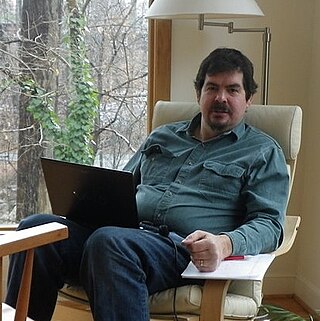Related Research Articles
Financial econometrics is the application of statistical methods to financial market data. Financial econometrics is a branch of financial economics, in the field of economics. Areas of study include capital markets, financial institutions, corporate finance and corporate governance. Topics often revolve around asset valuation of individual stocks, bonds, derivatives, currencies and other financial instruments.

Lars Peter Hansen is an American economist. He is the David Rockefeller Distinguished Service Professor in Economics, Statistics, and the Booth School of Business, at the University of Chicago and a 2013 recipient of the Nobel Memorial Prize in Economics.
Christian Gouriéroux is an econometrician who holds a Doctor of Philosophy in mathematics from the University of Rouen. He has the Professor exceptional level title from France. Gouriéroux is now a professor at University of Toronto and CREST, Paris [Center for Research in Economics and Statistics].

William Arnold Barnett is an American economist, whose current work is in the fields of chaos, bifurcation, and nonlinear dynamics in socioeconomic contexts, econometric modeling of consumption and production, and the study of the aggregation problem and the challenges of measurement in economics.
Tim Peter Bollerslev is a Danish economist, currently the Juanita and Clifton Kreps Professor of Economics at Duke University. A fellow of the Econometric Society, Bollerslev is known for his ideas for measuring and forecasting financial market volatility and for the GARCH model.

In finance, volatility is the degree of variation of a trading price series over time, usually measured by the standard deviation of logarithmic returns.
Marc Leon Nerlove was an American agricultural economist and econometrician and a distinguished university professor emeritus in agricultural and resource economics at the University of Maryland. He was awarded the John Bates Clark Medal from the American Economic Association (AEA) in 1969 and held appointments at eight different universities from 1958–2016. The Clark Medal is awarded to an economist under the age of 40 who “is judged to have made the most significant contribution to economic thought and knowledge”, and when the AEA appointed him as a distinguished fellow in 2012, they cited his development of widely used econometric methods across a range of subjects, including supply and demand, time series analysis, production functions, panel analysis, and family demography.
In financial econometrics, the Markov-switching multifractal (MSM) is a model of asset returns developed by Laurent E. Calvet and Adlai J. Fisher that incorporates stochastic volatility components of heterogeneous durations. MSM captures the outliers, log-memory-like volatility persistence and power variation of financial returns. In currency and equity series, MSM compares favorably with standard volatility models such as GARCH(1,1) and FIGARCH both in- and out-of-sample. MSM is used by practitioners in the financial industry for different types of forecasts.
Pietro Balestra was a Swiss economist specializing in econometrics. He was born in Lugano and earned a B.A. in economics from the University of Fribourg. Balestra moved for graduate work to the University of Kansas and Stanford University. He was awarded the Ph.D. in Economics by Stanford University in 1965.
Realized variance or realised variance is the sum of squared returns. For instance the RV can be the sum of squared daily returns for a particular month, which would yield a measure of price variation over this month. More commonly, the realized variance is computed as the sum of squared intraday returns for a particular day.
Nowcasting in economics is the prediction of the very recent past, the present, and the very near future state of an economic indicator. The term is a portmanteau of "now" and "forecasting" and originates in meteorology. Typical measures used to assess the state of an economy, such as gross domestic product (GDP) or inflation, are only determined after a delay and are subject to revision. In these cases, nowcasting such indicators can provide an estimate of the variables before the true data are known. Nowcasting models have been applied most notably in Central Banks, who use the estimates to monitor the state of the economy in real-time as a proxy for official measures.
Kenneth David West is the John D. MacArthur and Ragnar Frisch Professor of Economics in the Department of Economics at the University of Wisconsin. He is currently co-editor of the Journal of Money, Credit and Banking, and has previously served as co-editor of the American Economic Review. He has published widely in the fields of macroeconomics, finance, international economics and econometrics. Among his honors are the John M. Stauffer National Fellowship in Public Policy at the Hoover Institution, Alfred P. Sloan Research Fellowship, Fellow of the Econometric Society, and Abe Fellowship. He has been a research associate at the NBER since 1985.
Monika Piazzesi received her PhD in economics at Stanford University. She was a recipient of the Deutsche Studienstiftung ERP (1997–2000). She has been the Joan Kenney Professor of Economics at Stanford University since 2010. She is also a senior fellow at the Stanford Institute for Economic Policy Research. In 2005, when she was an assistant professor at the University of Chicago Business School, she received the Germán Bernácer Prize. She subsequently won the Elaine Bennett Research Prize. Her research focuses on asset pricing and time series econometrics, especially related to bond markets and the term structure of interest rates. She has published papers related to housing issues, asset prices and quantities, bond markets, interest rate and GDP. In 2023, she was elected to the National Academy of Sciences.

Laurent-Emmanuel Calvet is a French economist and a professor of finance. He is Vice President Elect of the European Finance Association.

John Philip Rust is an American economist and econometrician. John Rust received his PhD from MIT in 1983 and taught at the University of Wisconsin, Yale University and University of Maryland before joining Georgetown University in 2012. John Rust was awarded the Frisch Medal in 1992 and became a fellow of the Econometric Society in 1993.
Barbara Rossi is an ICREA professor of economics at Universitat Pompeu Fabra, a Barcelona GSE Research Professor, a CREI affiliated professor and a CEPR Fellow. She is a founding fellow of the International Association of Applied Econometrics, a fellow of the Econometric Society and a director of the International Association of Applied Econometrics.

Oded Lowengart is Professor of Marketing at the Ben-Gurion University of the Negev (BGU) in Israel, where he holds the Ernest Scheller Jr. Chair in Innovative Management and is Head of the Department of Business Administration. His two terms as Dean of the Guilford Glazer Faculty of Business and Management (2013–18) saw to opening the International MBA Program, expanded global programs, and increased Journal Citation Reports-ranked research publications.
Peter Arcidiacono is an American economist and econometrician. After receiving his Ph.D. from the University of Wisconsin–Madison in 1999, he has taught at Duke University. He became a fellow of the Econometric Society in 2018.
Siddhartha Chib is an econometrician and statistician, the Harry C. Hartkopf Professor of Econometrics and Statistics at Washington University in St. Louis. His work is primarily in Bayesian statistics, econometrics, and Markov chain Monte Carlo methods.
The Aruoba-Diebold-Scotti Business Conditions Index is a coincident business cycle indicator used in macroeconomics in the United States. The index measures business activity, which may be correlated with periods of expansion and contraction in the economy. The primary and novel function of the ADS index stems from its use of high-frequency economic data and subsequent high-frequency updating, opposed to the traditionally highly-lagged and infrequently-published macroeconomic data such as GDP.
References
- ↑ "Francis Diebold Personal Website".
- ↑ "Past Presidents, Founding Council, and Founding Members". Society for Financial Econometrics.
- ↑ "FRB: Model Validation Council". Board of Governors of the Federal Reserve System. 2012-04-30. Archived from the original on 2012-09-17.
- ↑ Diebold, Francis X.; Mariano, Robert S. (2002-01-01). "Comparing Predictive Accuracy". Journal of Business & Economic Statistics. 20 (1): 134–144. CiteSeerX 10.1.1.352.9389 . doi:10.1198/073500102753410444. ISSN 0735-0015. S2CID 12090811.
- ↑ Diebold, Francis X.; Gunther, Todd A.; Tay, Anthony S. (1998). "Evaluating Density Forecasts, with Applications to Financial Risk Management" (PDF). International Economic Review. 39 (4): 863–883. doi:10.2307/2527342. JSTOR 2527342. S2CID 38907468.
- ↑ Diebold, Francis X. (2001). Elements of Forecasting. South-Western. ISBN 9780324023930. OCLC 44493316.
- ↑ Andersen, Torben G.; Bollerslev, Tim; Diebold, Francis X.; Labys, Paul (2003-03-01). "Modeling and Forecasting Realized Volatility". Econometrica. 71 (2): 579–625. CiteSeerX 10.1.1.200.1388 . doi:10.1111/1468-0262.00418. ISSN 1468-0262. S2CID 10045723.
- ↑ Andersen, Torben G.; Bollerslev, Tim; Diebold, Francis X.; Labys, Paul (2001-03-01). "The Distribution of Realized Exchange Rate Volatility". Journal of the American Statistical Association. 96 (453): 42–55. CiteSeerX 10.1.1.199.9567 . doi:10.1198/016214501750332965. ISSN 0162-1459. S2CID 5756201.
- ↑ Christensen, Jens H. E.; Diebold, Francis X.; Rudebusch, Glenn D. (2011-09-01). "The Affine Arbitrage-Free Class of Nelson–Siegel Term Structure Models". Journal of Econometrics. Annals Issue on Forecasting. 164 (1): 4–20. CiteSeerX 10.1.1.524.355 . doi:10.1016/j.jeconom.2011.02.011. S2CID 774960.
- ↑ Diebold, Francis X.; Li, Canlin (2006-02-01). "Forecasting the Term Structure of Government Bond Yields". Journal of Econometrics. 130 (2): 337–364. CiteSeerX 10.1.1.195.536 . doi:10.1016/j.jeconom.2005.03.005.
- ↑ Francis X. Diebold; Glenn D. Rudebusch (2013). Yield Curve Modeling and Forecasting: The Dynamic Nelson-Siegel Approach. Princeton University Press. ISBN 978-0-691-14680-5.
- ↑ Diebold, Francis X.; Nerlove, Marc (1989). "The Dynamics of Exchange Rate Volatility: A Multivariate Latent Factor ARCH Model". Journal of Applied Econometrics. 4 (1): 1–21. doi:10.1002/jae.3950040102. S2CID 153347317.
- ↑ Diebold, Francis X.; Rudebusch, Glenn D.; Borag?an Aruoba, S. (2006-03-01). "The Macroeconomy and the Yield Curve: A Dynamic Latent Factor Approach". Journal of Econometrics. 131 (1): 309–338. CiteSeerX 10.1.1.232.9123 . doi:10.1016/j.jeconom.2005.01.011.
- ↑ Andersen, Torben G; Bollerslev, Tim; Diebold, Francis X; Vega, Clara (2003). "Micro Effects of Macro Announcements: Real-Time Price Discovery in Foreign Exchange". American Economic Review. 93 (1): 38–62. CiteSeerX 10.1.1.201.3408 . doi:10.1257/000282803321455151. ISSN 0002-8282.
- ↑ Diebold, Francis X.; Rudebusch, Glenn (1996). "Measuring Business Cycles: A Modern Perspective" (PDF). Review of Economics and Statistics. 78 (1): 67–77. doi:10.2307/2109848. JSTOR 2109848.
- ↑ "Aruoba-Diebold-Scotti Business Conditions Index".
- ↑ Aruoba, S. Boragan; Diebold, Francis X.; Scotti, Chiara (2009-10-01). "Real-Time Measurement of Business Conditions". Journal of Business & Economic Statistics. 27 (4): 417–427. CiteSeerX 10.1.1.395.7519 . doi:10.1198/jbes.2009.07205. ISSN 0735-0015. S2CID 219594039.
- ↑ Diebold, Francis X.; Yilmaz, Kamil (2014-09-01). "On the Network Topology of Variance Decompositions: Measuring the Connectedness of Financial Firms" (PDF). Journal of Econometrics. 182 (1): 119–134. doi:10.1016/j.jeconom.2014.04.012. hdl:10419/108574.
- ↑ Demirer, Mert; Diebold, Francis X.; Liu, Laura; Yilmaz, Kamil (2018). "Estimating Global Bank Network Connectedness". Journal of Applied Econometrics. 33 (1): 1–15. doi:10.1002/jae.2585. hdl: 10419/129366 . S2CID 36035680.